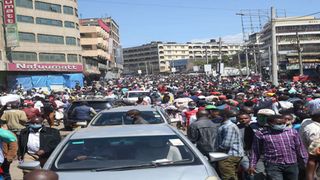
Nairobi residents go about their business at the Gikomba market on November 15, 2020. The high Covid-19 fatalities in the country has sparked fears among health experts.
|Covid-19: Concern as virus deaths hit months-high peak
What you need to know:
- Last week also saw the number of fatalities rise for the sixth week in a row, peaking at 152.
- In October, the country saw an average of 70 deaths weekly, and November could see it double to around 150, pushing estimates to over 500 deaths this month.
- An analysis of the fatalities shows that August was the third deadliest month with 233 deaths.
November is set to be the country’s gloomiest month in its Covid-19 fight with over 270 deaths recorded in the last two weeks that also saw its number of confirmed cases top 14, 000.
So deadly is Covid-19 this month that, with the current trend in fatalities — just 15 shy of October’s total of 285 — November is headed to be the worst in terms of deaths with projections north of 500, even as critical and severe cases in the country rise. By Saturday, the country had recorded 1,249 deaths.
Latest data from the Health ministry shows that, on average, 20 Kenyans have been losing their lives on a daily basis, even as the three-week average of critical care patients remains almost constant at 51, meaning, a similar average of patients are admitted to both the High Dependency Units (HDU) and Intensive Care Units (ICUs) across the country daily.
Last week also saw the number of fatalities rise for the sixth week in a row, peaking at 152. In October, the country saw an average of 70 deaths weekly, and November could see it double to around 150, pushing estimates to over 500 deaths this month.
The double-digit deaths are being blamed on the high number of patients seeking treatment as community infections soar, exposing vulnerable and immune-compromised age groups.
233 deaths
An analysis of the fatalities shows that August was the third deadliest month with 233 deaths, followed by July with 193, September (133), June (85), May (46) and April (17).
Nairobi still leads the country with the number of deaths now at over 600, followed by Kiambu, Mombasa and Nakuru, a summary of the data by the Health ministry and seen by the Nation shows.
Last month, the country had over 15,000 new cases, a feat that is already broken this month, with two weeks to the end of it signalling serious trouble ahead. Last Friday, the country registered one of the highest numbers of infections in a day at 1,470.
Health CS Mutahi Kagwe says, 1,185 of Covid-19 patients are admitted to hospital, with 58 of them under intensive care (ICUs).
“Of the 58, 23 are on ventilatory support and 30 on supplemental oxygen. Ninety are separately on supplemental oxygen, 75 of them in general wards and 15 in high dependency units (HDUs),” Mr Kagwe said, adding that 5,794 people were in home-based care (HBC).
Of those in HBC Nairobi led at 1,190, followed by Kiambu (542), Nakuru (482), Uasin Gishu (472) and Mombasa (383). Last month, the Covid-19 cases saw daily average infections rising at between 15 and 18 per cent, but this has also since jumped to an average of 24 per cent this month.
With over 14,000 new infections this month alone, experts have raised the alarm over this trend, with Africa Centres for Disease Control and Prevention (Africa CDC) director John Nkengasong announcing plans to visit the country to join discussions on measures to correct this 34 per cent increase in infections.
Latest data from a team of researchers at the Health ministry, including Health Acting Director-General Patrick Amoth and Dr Loice Ombajo, Head of Infectious Disease Unit at Kenyatta National Hospital (KNH), and the Kenya Medical Research Institute (Kemri) shows that, of the country’s Covid-19 admissions, 43 per cent were found to have underlying chronic conditions, especially cardiovascular diseases (17 per cent), diabetes mellitus (15 per cent), HIV (7 per cent), malignancies (4 per cent), chronic kidney disease (3 per cent) and chronic airway disease (3 per cent).
For the fatalities, the researchers found that they were more likely to be older, have an underlying co-morbidity more so cardiovascular disease, diabetes mellitus, renal insufficiency, and chronic obstructive airway diseases.
Worse outcomes
“We found significantly increased risk of death with older age, above 60, and of male gender and in patients with co-morbidities. Men with Covid-19 have been shown to be at higher risk for worse outcomes and mortality irrespective of age. Possible explanations for this include the higher prevalence of high-risk behaviour, including smoking and attendant lung injury, higher prevalence of underlying co-morbidities and other yet to be fully defined biologic differences,” the researchers said in their paper published last week in the online medical Journal Medrxiv.
Meanwhile, more than 38 Form Four students at Kabarnet Boys High School have tested positive, Baringo County Commissioner Henry Wafula has confirmed.
He said, however, that the school will not be closed and that the infected students will be treated in an isolation dormitory that has been set aside within the school.
Additional reporting by Florah Koech





